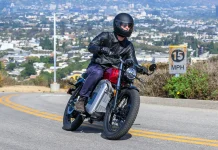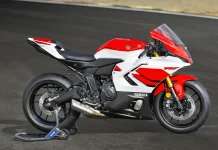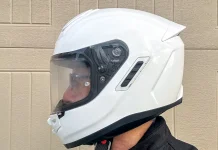Just when I thought there was no more functionality to add to motorcycle helmet communicators, Sena releases a new flagship. The Sena 60S is at the top of the range, improving on the 50S released in 2020.
Silly me, thinking we were at the pinnacle of what could be imagined and offered in the product lineup. The Sena 60S provides a slew of additions and improvements to get excited about. There are functions I had never imagined would be incorporated into one of these units, and I’ve used and reviewed all the majors.
While your crew may lean toward one brand or another due to intercom compatibility, the new Sena 60S offering is mighty tempting. You may also decide you don’t need what’s on offer. Me? Go big or go home!
Let’s start with the mesh intercom. The new Mesh 3.0 software is an upgrade from Mesh 2.0. It provides improved sound quality and a more reliable connection during adverse conditions, such as when riders spread out too far or disappear around canyon walls and large obstacles.
I’ve written before about signal loss, even with the best units, and that is mitigated to a degree with the 60S. Sena claims Bluetooth 5.3 and Mesh 3.0 extend talk time to 17 hours. I reckon that’ll be good for the Iron Butt crowd, though I’ve never needed more than 10 hours. Still, as is often said, more is usually better.
I did experience some of the same intercom dropouts typical of all motorcycle helmet communications units at extreme ranges or around canyon walls. That is expected with transmitters of such small size and power.
The 60S intercom is backward-compatible, though not automatically. 60S users can connect with Mesh 2.0 users, but only after switching to 2.0 in the Sena Motorcycle app. Mesh 3.0 does not talk to 2.0, so you must run the 60S in 2.0 to connect with older units. I did find that the 50-series units will now run Mesh 2.0 and 3.0, as well, due to a recent firmware update, as will the Shoei Comlink SRL2 and SRL Mesh units. Others may follow but I do not have all models in hand to test.
I’ve ridden over 400 miles using the 60S to communicate with pals sporting several older models from Sena—not only on mesh intercom but also through the BT intercom. Mesh hooked up with other mesh pals on open mesh channel 1, on the fly by simply pressing the mesh button. Sena’s mesh allows us to segment the group on different channels. However, in our three- and four-rider groups, we simply stayed on channel 1.
Connecting the Sena 60S with an older 20S unit using the BT intercom is easy using the Sena Motorcycle app. In this case, there were only two of us. We loaded the app on our smartphones, and they connected to our respective units. I scanned the QR code in the other rider’s app and, presto, we were connected.
We rode 230+ miles together without a single signal dropout. Granted, we stayed relatively close to one another (less than a half mile). The voice quality was excellent, and we did not experience any static or noise.
While we are on the subject, the Sena Motorcycle app is excellent, making every function of the unit easy to operate—check out some of the controls in the screenshots in our gallery. As with earlier models, the app is not required. While changes to user selections can be made directly through the unit itself, it’s not nearly as convenient.
A feature debuting with the Sena 60S is Wave Intercom. In a nutshell, the Wave app—iOS and Android—works with a smartphone that is connected to cell service. This enables riders “to stay connected with fellow riders, irrespective of the brand of each device, and even friends and family who aren’t on the road, from virtually anywhere on Earth,” according to Sena Technologies Senior Marketing Manager Tim Seargeant. This functionality happens through the power of Voice-Over-IP (VOIP), which requires a cell connection. It works smoothly, but remember, you must have a live cell connection for this magic to happen.
Some of the highlights of this unit’s functionality include connecting with nearby Wave users with a button press, connecting with pals on a predefined list, display of real-time locations of active Wave friends, automatic switching between Wave to mesh based on cell service coverage, and AI-powered control of the unit and Wave app through speech.
The 60S is optimized for Wave to be controlled through buttons on the unit. Legacy models, such as the 50 series, will be Wave-compatible through a firmware update.
Users may update their firmware through the Sena Motorcycle app if their smartphone is connected to the Internet. Gone are the days of using a special Wi-Fi-equipped charging cable. The app will tell you when you need to update. One click later and Bob’s your uncle. The old-school Sena Device Manager still works on desktops, though the app renders it virtually obsolete. The update ran in three concurrent segments and took less than five minutes for me to successfully accomplish.
Audio by Harmon Kardon has been upgraded to 2nd generation. This offers louder sound and Sena claims “richer dynamics for superior audio.” I’m no audiophile, yet I love how my playlist sounds with the 60S. The 40mm diameter speakers remain the same size for helmet socket compatibility.
Sena runs its noise cancellation through AI on a dual-core CPU using parallel architecture. Sena says this improves “ambient noise suppression and echo cancellation for clear voice transmission.” It sounded good to me, though the software does not cancel noise as well as my Apple AirPods. Overall, the Sena 60S is my best aural in-helmet experience to date.
Still not impressed? The 60S has a built-in flashlight, which, at the push of a button on the front face, delivers wide beam illumination in a pinch. The flashlight is for close-up work, including rummaging through a side or top case at night.
The Sena 60S has the typical blue flashing light on the side to show it is operating. Sena has added a RideGlow LED that is a flowing illuminated strip across the face of the unit, coursing like a stream from top right to center bottom. It can be customized in the app for brightness and 12 color schemes, or turned off. It does nothing to add functionality but looks mighty impressive, especially if you match it to your chassis lighting system.
Sena waterproofs the 60S to IPX7 standards, so rain is no problem. I didn’t test this, but the standard says the 60S will survive immersion in water up to a meter deep for up to 30 minutes. If one of you ADV guys takes a swim with it, let me know how it goes.
A nice bonus is that the 60S arrives with two helmet clamp kits, three microphones, two sets of speakers, and enough double-sided tape and hook-and-loop to accommodate two helmets. One adhesive mount is included, and I used it for installing the 60S for testing on the Scorpion Exo-Apex Eclipse helmet.
Interestingly, the two clamp kits are different. One clamp kit can utilize either a short boom mic or a button mic for a full-face helmet. The other mount has a permanently mounted long boom mic that works for an open-face or jet-type helmet. If you want to put the second clamp kit on a second full-face helmet, just bend and guide that long boom under the edge of your helmet for the mic to reach your mouth.
Installation is typical of any brand’s communicators. Simply remove the helmet’s cheek pads, attach the unit via clamp or adhesive, place the speakers and mic, run wires between the helmet liner and shell, and replace the cheek pads—you’re done.
After charging the unit, pair it with your smartphone—the 60S automatically goes into phone pairing mode the first time you power it up. Your smartphone’s Sena Motorcycle app will connect to the 60S and tell you whether you need to update the firmware. Mine told me to do this, which was a matter of one button press.
The device drops onto the mount and hooks up magnetically, so the 60S is easily attached and detached. There is the same pop-up antenna used on some earlier models, and the jog wheel is a pleasure to use.
The software is evolving fast at Sena. As of this writing and as mentioned earlier, Mesh 3.0 has been rolled out to 50S and 50R models, plus the Sena-sourced Shoei Comlink SRL2 and the earlier SRL Mesh. Take a minute with your group to ensure everyone is updated, as Mesh 2.0 and Mesh 3.0 standards are incompatible. If Mesh 2.0 is all one of the other units can use, you’ll all have to go with Mesh 2.0.
After several months and many miles, the Sena 60S has proven to be a solid and reliable addition to my mandatory riding equipment. While I have always enjoyed and appreciated Sena’s equipment over the years, the new features are welcome and pleasing. Great fidelity with my music, clear communication with riding buddies, and ease of use all contribute to the Sena 60S being an important upgrade.
Sena 60S Specs
ELECTRONICS
- Talk time: Bluetooth, up to 24 hours; mesh, up to 17 hours
- Battery charge time: 90 minutes
- Intercom software: Mesh Intercom 3.0; Mesh Intercom 2.0; Bluetooth Intercom
- Mesh intercom working distance: Up to 1.2 miles unobstructed (5 miles with 6 or more riders)
- Bluetooth working distance: Up to 1.2 miles unobstructed
- Bluetooth: 5.3
- Group maximum: 24 in Mesh; 4 in Bluetooth
- Speakers: Harmon Kardon 2nd Generation
- Certifications: CE, FCC, IC, KC, J-MIC, SRRC
DIMENSIONS
- Height: 2.0 inches
- Width: 3.3 inches
- Depth: 1.1 inches
- Weight: 2.4 ounces
- Speaker diameter: 40mm
- Speaker depth: 8.6 mm
- Warranty: 3 years
Sena 60S Price: $399 MSRP (Dual Pack: $749)
















